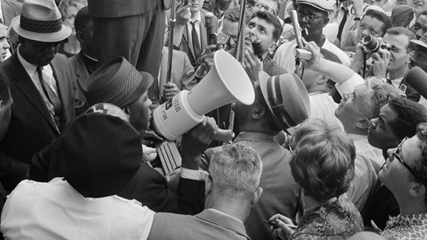The ninth-grade students at STAR (Science Technology and Research) Academy in Brooklyn, New York, are all talking at once. There’s nothing out of the ordinary here, of course. But they are not having side conversations as I wrap up the day’s lesson. They are arguing with each other. As their voices fluctuate between belligerent assertions and inaudible inquiries, I search the classroom for a ball, a giant pencil, a ruler—anything that would bring my students to order. I ultimately settle for a stapler. This stapler will act as a talking stick or a mike: one mike, one voice, I tell them.
I’m here at STAR Academy as a writer in the schools with Teachers & Writers Collaborative (T&W) to teach argumentative essays. For this group of ninth-grade English Language Arts students I’ve chosen current events relating directly to urban teens: pregnancy prevention ads, the NYPD’s Stop and Frisk law, and the Stop-the-Sag campaign where teens are fined for wearing their pants way below their hips to reveal their underwear. I’ve asked them to examine each topic in detail, using web articles, videos, current photographs, and historical images as primary resources, and have found that as their knowledge about these topics deepens, so does their passion. The opinions they form are colored by both.

These strong opinions filter into classroom discussions where it’s hard for me or the classroom teacher to get a word in edgewise. After all, this is one scenario where our opinions do not matter. Teen pregnancy ads are not aimed at us, and we are well aware it would be very unflattering for us to sag. But what does matter in this English classroom is making sure that each student is heard; that each student has a chance to cultivate their voice by speaking their truth loud and clear.
The newly-introduced Common Core standards call for students to become proficient in researching and writing an argumentative essay, and I believe the passion these students are showing in these classroom discussions are an essential part of the process. Their vocal declarations consist of a series “should” and “should nots”; “rights” and “wrongs;” which create an echo chamber of conundrums that brings us back to, “well, because…” Clarity of thought, research, and critical thinking skills are all essential to a compelling argumentative essay, and we make sure the students know this. But without a strong conviction for the ideas expressed, the words on the page can fall flat, leaving the reader with loosely-threaded reasons and citations that barely support a claim. Conviction in an argumentative essay is conveyed through voice. Argumentative essays do not simply persuade, they move and challenge the reader. They are a call to action.
How do we begin to help students cultivate this voice? Enter the manifesto. The manifesto proclaims and shouts into a megaphone. The manifesto speaks with authority and challenges the audience to embrace a new idea; it is unwavering and resilient. The manifesto as a form can help nurture the courageous argumentative voice.
According to the Oxford English Dictionary, a manifesto is defined as “a public declaration of policy and aims.”While it isn’t described as such, Suheir Hammad’s poem “What I Will” includes some of the necessary elements for a manifesto. It is a list of assertions and demands. There is an unwavering voice. There is repetition and rhythm like a pulsing clarion call for dissent. The poem is a perfect entrée to use to jumpstart my introduction to the manifesto.
When I ask the students what word is repeated most often in Hammad’s poem, they all answer, “will.” The repetition of “will” and “will not” throughout the poem allows the speaker to express the certainty and determination that characterize the manifesto. As in Hammad’s poem, I tell the students, there is no room for tentativeness and doubt in the manifesto or in the argumentative essay. Essentially, I tell them, manifestos have three simple criteria: a problem, a solution, and an outcome.
Problem: What needs to change?
Solution: How do you change it?
Outcome: What will happen once this change takes place?
As an example, I show them excerpts from Dr. Martin Luther King’s Letter from Birmingham Jail, written on April 16, 1963,after King was jailed while marching in Alabama with other activists. After they’ve read this part of King’s letter, I give them a chart to identify the problem, solution, and outcome in the excerpt.
Problem: Violence and non-negotiation.
Solution: Non-violent sit-ins and marches to create tension
Outcome: Negotiation
Once they’ve done this, I ask the students to note how Dr. King reinforced his objectives with the repetition of “We seek to,” adding urgency to the tone of the piece. I also show them that within the excerpt, is the framework for an argumentative essay, which starts by making a claim or a debatable assertion. I ask the students to identify King’s claim in the piece. This was more challenging for them. We had to ask, what is Dr. King’s position? How does he support this position throughout this excerpt? And is it debatable?
Claim: Nonviolent direct action seeks to create such a crisis and foster such a tension that a community which has constantly refused to negotiate is forced to confront the issue.
Another excellent example of the manifesto I share with my students is “The Hacker’s Manifesto” written by a twenty-year-old hacker Loyd Blankenship, under the moniker The Mentor, on January 8th, 1986 in Volume 1 Issue 7 of Phrack Magazine. We read the piece together. It begins with the arrest of an unnamed hacker, which the writer presents as one more piece of evidence for how hackers are misunderstood. Throughout the piece, he compares what society thinks of hackers (they’re criminals, they’re all alike) vs. what he says is the reality (they’re creative, smart, against the hypocrisy of the world). A megaphonic voice is evident through the whole piece. The author is audacious, clear, and firm in his reasoning. I ask the students: How can this manifesto expanded into an argumentative essay? What would be the claim that would start such an essay and how would you support it with evidence?
Claim(s): Hackers are seen as delinquents and underachievers, when they are actually highly intelligent people who use technology to fight corruption and hypocrisy.
We highlight elements in the manifesto that directly relate to elements in the argumentative essay and notice that the writer’s tactic in this piece is to support his claim by repeating a counterclaim throughout the manifesto (hackers are all alike) and then knocking it down. The students all agree that the writer is asserting what others’ opinions are of young hackers. What if our counterclaims were written throughout our essays as a way to strengthen our arguments? When the students begin writing their argumentative essays with all the elements of manifestos in mind, they discover that repetition can reinforce their claims and amplify their voices. Crafting the argumentative essay becomes a much less daunting experience once they get a sense of how to use their voice.
Reading and examining manifestos as a prelude to writing an argumentative essay encourages students to assert their opinions confidently and boldly. Most high school students are vocal and are determined to have their views heard. But argumentative writing can be intimidating. Their innate passions are sometimes muted and their voice barely whispers from the page. The manifesto provides a megaphone. It can help students understand how to project their voice, their opinions, their audacious dreams and aspirations far and wide, an essential first step in their efforts to create confident and captivating argumentative essays.
Ibi Zoboi's short stories have been anthologized in Dark Matter: Reading the Bones, Haiti Noir edited by Edwidge Danticat, and The Caribbean Writer, among others. She’s received grants in Literature & Writing from the Brooklyn Arts Council and is a winner of the Speculative Literature Foundation Travel Award. Ibi is an MFA student in Writing for Children & Young Adults at Vermont College of Fine Arts.



